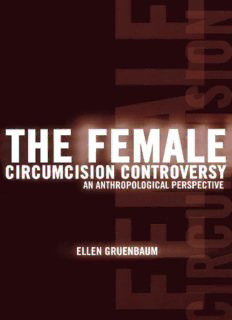
The Female Circumcision Controversy: An Anthropological Perspective PDF
Preview The Female Circumcision Controversy: An Anthropological Perspective
The Female Circumcision Controversy This page intentionally left blank The Female Circumcision Controversy An Anthropological Perspective Ellen Gruenbaum PENN University of Pennsylvania Press Philadelphia Copyright © 2001 Ellen Gruenbaum All rights reserved Printed in the United States of America on acid-free paper 10 9 8 7 6 5 4 Published by University of Pennsylvania Press Philadelphia, Pennsylvania 19104-4011 Library of Congress Cataloging-in-Publication Data Gruenbaum, Ellen. The female circumcision controversy : an anthropological perspective / Ellen Gruenbaum. p. cm. Includes bibliographical references and index. ISBN 0-8122-3573-8 (cloth : alk. paper) - ISBN 0-8122-1746-2 (pbk. : alk. paper) 1. Female circumcision. I. Title. GN484 .G78 2000 392.1 -dc21 00-041803 For my parents, Ruth and Luther Gruenbaum This page intentionally left blank Contents Introduction: Grappling with the "Female Circumcision'1 Controversy 1 1. Patriarchy 36 2. Ritual and Meaning 48 3. Marriage and Morality 76 4. Ethnicity 102 5. Sexuality 133 6. Economic Development 158 7. Change 176 8. Involvement 198 Appendix: Organizations That Focus on Female Genital Cutting Issues 223 Glossary 225 Bibliography 227 Index 237 Acknowledgments 241 This page intentionally left blank Introduction Grappling with the "Female Circumcision" Controversy To outsiders, the practice euphemistically known as "female circumci- sion" is shocking. That people surgically alter the genitals of young girls and women, usually in painful and unhygienic procedures that can cause grave harm to their health, seems truly horrible. Why do loving parents allow such things to happen? How can they bring themselves to celebrate these events? How can they justify the practice when occasionally a girl dies from the injuries? The horror female circumcision evokes is grist for outrage, electrifying a cry for urgent change. At the new millennium, there are still millions of girls and women in dozens of countries who bear the scars of cutting done to their genitalia early in life. Worldwide, it is estimated that an additional two million girls too young to give their consent undergo some form of female genital cutting each year. How can this be? This book offers an exploration of the female circumcision practices themselves, the reasons they are done, examples of the social contexts, the health, social, and sexual consequences, and the controversies sur- rounding the process of change. It addresses many of the most frequent questions and challenges I have encountered in teaching and lecturing about these topics, with the intention to improve understanding, reduce simplistic denunciation, and provide a solid grounding for those who decide to support reform efforts. For people outside the cultural contexts where female circumcision is still practiced, developing understanding requires much more than merely knowing the facts or arriving at a philo- sophic position for or against. To allow readers more opportunity to consider the social contexts and the human experience, I include narra- tives and examples from my ethnographic research in Sudan.
Description: